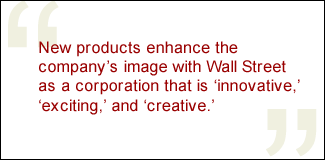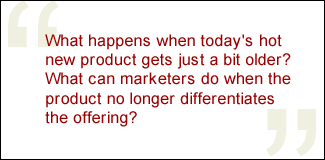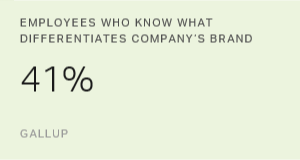Much has been written about new products, detailing what a successful fresh offering can mean for a corporation. While the new product failure rate continues to be frighteningly high -- typically more than 8 in 10 fail to make the grade in packaged goods -- the search goes on.

|
There are some obvious reasons why companies hold new products in high esteem. Like Procter & Gamble's Swiffer, fresh offerings can show growth through added sales volume, and they can help solidify and broaden the company's reach. Perhaps less obviously, they serve as company "heroes," energizing the organization and elevating its profile. They enhance the company's image with Wall Street as a corporation that is "innovative," "exciting," and "creative."
Recent commentary by Al Ries expands on these benefits, stressing the "halo" effect that can derive from new products. Ries mentions several new releases that not only have proven successful in themselves but also have helped elevate the company's overall business. Two examples he cites are Apple's iPod and Motorola's Razr cell phones.
The halo effect
There's no doubt that the iPod and Razr have generated revenue and profits as well as considerable marketplace buzz. Moreover, sensing the potential of their new offerings, Apple and Motorola redirected their advertising and promotional efforts to focus heavily on these high-buzz and high-fashion products. The result: a higher profile for the parent company -- and a cutting-edge image in an age where many consider this sort of image essential.
The benefits of a strong addition to a company's product lineup can also be found in categories as wide-ranging as autos and fast food. And so automakers strive for the next Escalade or Prius, Pizza Hut hunts for the next stuffed-crust pizza, and Taco Bell searches for one more chalupa. Each of these new offerings has been credited for sales increases as well as elevated customer images. They demonstrate that today's consumers want to shop, own, display, and be associated with what's "hot."
That's partly what RadioShack is aiming for as it attempts to reenergize its business by freshening its merchandise, adding flat-panel TVs to its store offerings. New products are the hoped-for company heroes, riding to the rescue.
But is that what business success is all about? What happens when today's hot new product gets just a bit older? And what happens when every pizza chain decides to offer a stuffed-crust pizza and every cell phone maker develops a slim Razr clone? What can marketers do when the product no longer differentiates the offering?

|
The counterargument, supported by anecdote as well as evidence, is that the company that's first with a new idea has an important head start on its rivals. And, like Swiffer or iPod, that product then defines the category in the minds of most consumers. Thus, while competitors may enter the fray, the company that's out in front with what's hot usually benefits the most.
So what does it take for a product or a company not just to be hot, but to stay that way? In addition, as companies redirect their resources in pursuit of what's new and exciting, what happens to the company's current offerings and to its current customers?
Bonds that reach beyond the product
Addressing the challenge of sustainable growth requires that companies look beyond their array of products, examining all points of consumer contact and assessing how well each touchpoint delivers on the company's brand promise. After all, the consumer's brand experience is comprised of many parts, and "Product" is not the only marketing "P" that matters. (See "The Power of the Fifth P" in the "See Also" area on this page.) Whether it's RadioShack, Cadillac, or Apple, each business must look not just at enhancing its product portfolio but also for opportunities to strengthen each of the ways it delivers on its brand promise.
Consider the case of Dell, the acknowledged dominator in PC sales. In response to recent declines in its market share and profit performance, the direct-to-consumer market pioneer didn't announce plans to launch another hot high-tech product. Instead, the company will open full-size Dell stores in Dallas and New York.
Shocking? Maybe not.
Like Apple's earlier decision to launch its own chain of retail outlets, Dell may be sensing an opportunity to introduce another potential brand-building hero: its employees. (See "Outsourcing the Brand" in the "See Also" area on this page.) Unlike Apple, the Dell stores will only carry display models of its products. Nonetheless, Dell may be exploring opportunities to leverage a marketing weapon that is rather different, at least for Dell. Adding the human element as a Dell customer touchpoint may help build its image as a company that has more than cutting-edge products delivered directly to customers. Through this additional retail contact point, Dell may add value by providing customer-friendly product experts. As Apple learned -- and as Gallup's research has shown -- that sort of enhanced relationship-building is probably best accomplished person-to-person. (See "When Will They Ever Learn?" in the "See Also" area on this page.)
It's unclear whether Dell's new retail brand ambassadors will succeed in reestablishing revenue momentum. What's certain, however, is that the company is looking beyond another new product launch to stimulate what is, in essence, a repositioning of the Dell brand experience.
Adding value through enhanced in-person contact has an additional benefit for companies seeking sustainable momentum. Excellence in human touchpoint performance is tougher to copy than a new product design. While this may be a new initiative for Dell, it's certainly not new to Lexus, JetBlue, Starbucks, or Ritz-Carlton. Adding "people" to "product" represents brand experience enhancement and business results that can last. These outcomes don't rise or tumble with the next new product life cycle. After all, people can be every bit as heroic as products.
